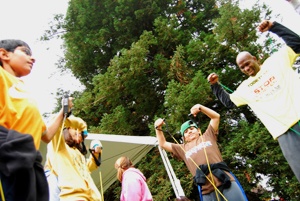 |
| Hundreds walked in the Seattle StepOut event to educate Diabetes sufferers about wellness, diet and, left, exercise. |
Hundreds of walkers took to the pavement this weekend in Seattle's StepOut event to fight a disease that affects 23.6 million Americans.
According to the American Diabetes Association, who hosted the event, African Americans and increasingly African immigrants are 1.6 times more likely to develop diabetes than Whites.
"One way or another we know someone who has diabetes," said Bianca Robinson, a participant of StepOut.
Robinson walked for her late brother, three other family members and a close friend who have all been diagnosed with the disease. During the walk Robinson said she witnessed a young girl getting an insulin injection and said it was touching, reminding her why she was out there.
Diabetes is marked by the body's insufficient production or rejection of insulin, which is vital for turning sugar into energy. Obesity and inactivity pave the way for type 2 diabetes, the most common form of the disease. When a person consumes too much fat and carbohydrates the pancreas overproduces insulin, causing it to ware out and/or an incorrect reaction in the body to the insulin.
Robert Arroyo, the chair of this year's event, compares this to the use of a car: if you drive your car across country every week then it is going to break down a lot quicker than if you just drove it to work.
Researcher James V. Neel at the University of Michigan Medical School argues that people who have traditionally not eaten "Western" diets, such as Africans and their descendents, Native Americans and Asian/Pacific Islanders, have a genetic trait that may in some way contribute to the illness. The "thrifty gene" that enabled ancestors to use food energy sufficiently during famine now, in the era of supermarkets, may make weight control difficult.
However obesity and genetics do not fully account for the 14.7 percent of Blacks in the U.S. who have diabetes, according to the ADA. The mystery remains why they, along with Asians, Latinos and Native Americans have a higher occurrence rate than Whites, whose rate of prevalence hovers around 7 percent.
"The African American community has been really hit hard by diabetes," said Linda Henderson, ADA's executive director for Washington and Northern Idaho. She is involved in an on-going effort to reach out to the region's high-risk minority groups and raise awareness.
"A lot of the damage is caused from not knowing that you have diabetes or pre-diabetes." Henderson explained that often a person will learn they are diabetic from an optometrist or dentist when complications are present in the eyes and mouth.
The ADA estimates that 5.7 million Americans are undiagnosed and 57 million are pre-diabetic. During the month of November the Association will be giving free screenings every Tuesday from 9 a.m. to 11:45 a.m. at the Seattle Uwajimaya grocery store.
"We sometime as African Americans tend to ignore things as far as our health goes; if it's not broke then don't fix it," explained Robinson, who recalls that her friend's brother died from complications of undiagnosed diabetes. "He totally missed being diagnosed. It could have saved his life. That is something I want to put out there: take the time, take care of yourselves and get check ups."
If a check up does lead to news of diabetes Bobby Heyer, diagnosed 30 years ago, wants people to know that they can manage the disease. He is part of Team Type 1 who, through triathlons, aims to inspiring other diabetics to take control with nutrition and physical activity.
"Don't be intimidated by exercise. It might scare you a bit as a diabetic, trying to balance a lot and then your throw in exercise," said Heyer. "You don't have to bike across country. We all started somewhere. We all went out for a one-mile run or biked around the block."














































































































































































































































































































